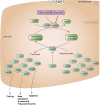Personalized approach of medication by indirect anticoagulants tailored to the patient-Russian context: what are the prospects?
- PMID: 23016735
- PMCID: PMC3492156
- DOI: 10.1186/1878-5085-3-10
Personalized approach of medication by indirect anticoagulants tailored to the patient-Russian context: what are the prospects?
Abstract
Indirect anticoagulants such as warfarin are the 'gold standard' for prevention and treatment of thromboembolic complications in patients at risk (in atrial fibrillation of valvular and nonvalvular etiology, the presence of artificial heart valves, orthopedic and trauma interventions, and other pathological conditions). A wide range of doses required to achieve a therapeutic effect indicates the need for a personalized approach to the appointment of warfarin. In addition to the dependence on the patient's clinical characteristics (sex, age, smoking status, diagnosis), there is a clear association between the warfarin dose and the carriage of certain allelic variants of key genes that makes it possible to apply molecular genetic testing for individual dose adjustment. This provides a more rapid target anticoagulant effect and also reduces the risk of bleeding associated with a possible overdose of warfarin. Implementation of this approach will allow more wide and safe application of indirect anticoagulants in Russia for needy patients.
Figures









Similar articles
-
Apixaban in Comparison With Warfarin in Patients With Atrial Fibrillation and Valvular Heart Disease: Findings From the Apixaban for Reduction in Stroke and Other Thromboembolic Events in Atrial Fibrillation (ARISTOTLE) Trial.Circulation. 2015 Aug 25;132(8):624-32. doi: 10.1161/CIRCULATIONAHA.114.014807. Epub 2015 Jun 23. Circulation. 2015. PMID: 26106009 Clinical Trial.
-
Use of oral anticoagulants in complex clinical situations with atrial fibrillation.Med Clin (Barc). 2018 Jun;150 Suppl 1:8-24. doi: 10.1016/S0025-7753(18)30666-3. Med Clin (Barc). 2018. PMID: 30502871 Review. English, Spanish.
-
Selection of Oral Anticoagulants in Ischemic Stroke Patients with Nonvalvular Atrial Fibrillation.J Stroke Cerebrovasc Dis. 2018 Oct;27(10):2627-2631. doi: 10.1016/j.jstrokecerebrovasdis.2018.05.036. Epub 2018 Jun 30. J Stroke Cerebrovasc Dis. 2018. PMID: 29970321
-
Use of oral anticoagulants in older patients.Drugs Aging. 2000 Jun;16(6):409-35. doi: 10.2165/00002512-200016060-00003. Drugs Aging. 2000. PMID: 10939307 Review.
-
Cost-effectiveness of using pharmacogenetic information in warfarin dosing for patients with nonvalvular atrial fibrillation.Ann Intern Med. 2009 Jan 20;150(2):73-83. doi: 10.7326/0003-4819-150-2-200901200-00005. Ann Intern Med. 2009. PMID: 19153410
Cited by
-
Personalized medicine and the clinical laboratory.Einstein (Sao Paulo). 2014 Sep;12(3):366-73. doi: 10.1590/s1679-45082014rw2859. Einstein (Sao Paulo). 2014. PMID: 25295459 Free PMC article. Review.
References
-
- Moyer TP, O'Kane DJ, Baudhuin LM, Wiley CL, Fortini A, Fisher PK, Dupras DM, Chaudhry R, Thapa P, Zinsmeister AR, Heit JA. Warfarin sensitivity genotyping: a review of the literature and summary of patient experience. Mayo Clin Proc. 2009;84(12):1079–1094. doi: 10.4065/mcp.2009.0278. - DOI - PMC - PubMed
LinkOut - more resources
Full Text Sources

